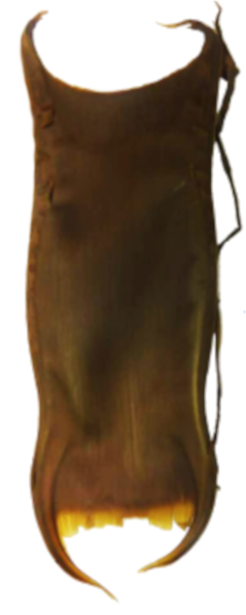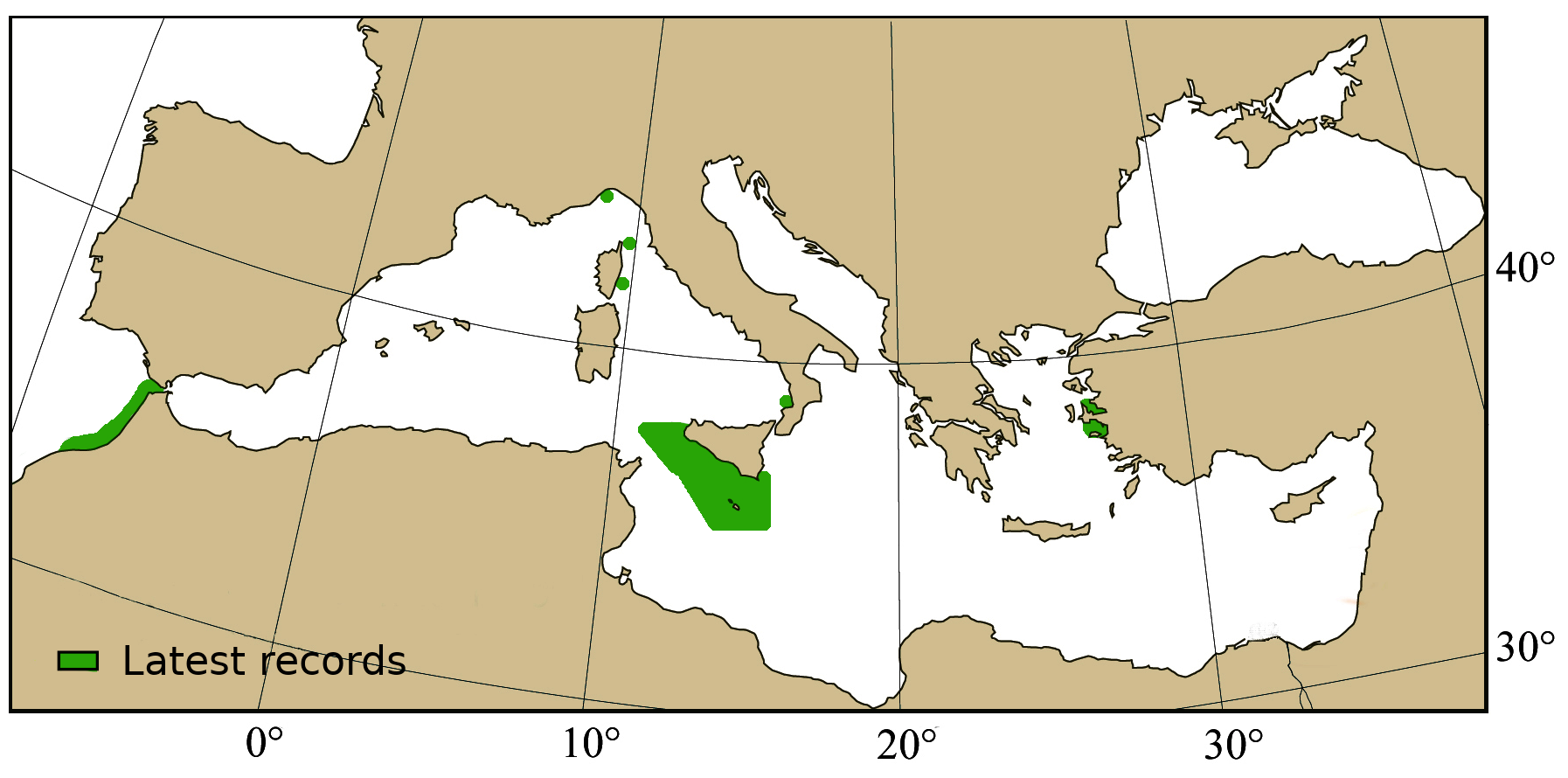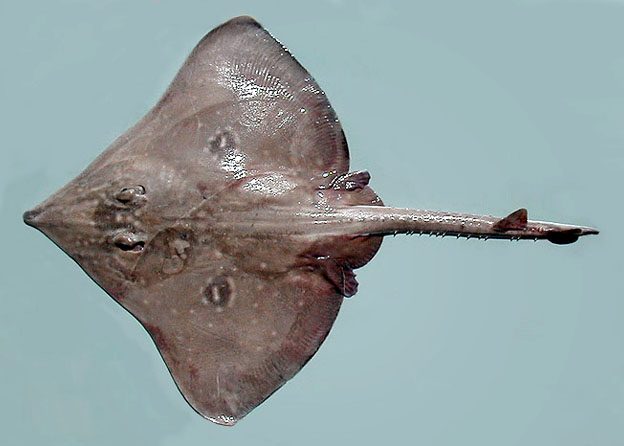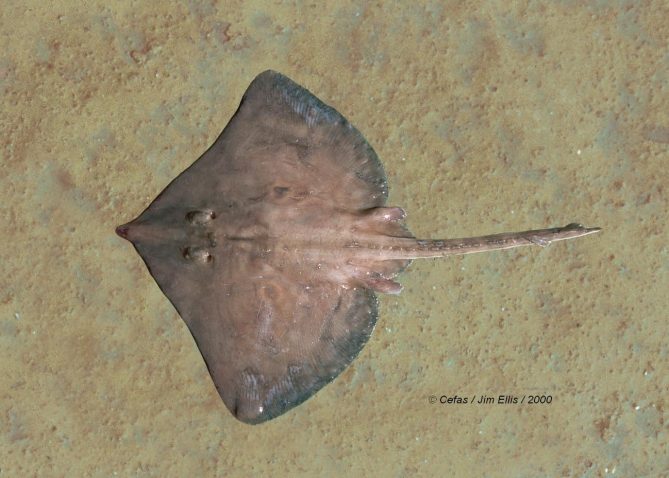Dipturus cf. batis
Common name: Common skate complex, Blue skate
Order: Rajiformes
Family: Rajidae
Synonyms: D. cf. fossada, D. cf. intermedia, Raja batis, Raja macrorhynchus
Misidentifications: D. nidarosiensis
Remark: Newly resurrected, Dipturus intermedius is still treated as a composite species in D. batis. The distinct distribution of the two species must be clarified.
Short description
Large body size. Long and pointed muzzle. Rhombic disc, with concave anterior margins. Smooth dorsal and ventral surfaces in juveniles, partially spiny in larger specimens. 12-31 spines along the tail. 40-56 tooth rows.
Color: Grey to olive-brown dorsal surface with light spot. Sometimes one ocella on each pectoral fin. Grey to blue-grey ventral surface.
Measurements:
- Total length (TL): 100-200 cm (max 285 cm based on historical records).
- Weight: up to 97 kg.
Swimming pattern: Undulatory and pelvic fin locomotion (walking and punting).
Egg case
Large capsules with rectangular shape and pointed horns at the corners, deposited on sandy or muddy bottoms.
Size: 10.6 – 24.5 cm length,
5 – 14.5 cm wide.
Distinctive features:
Dipturus: Short horns or reduced to a simple shape. Length > 100 mm.
Rajiformes / Rajidae: Rectangular egg-case, width no greater than twice the capsule length.

Biology / Ecology
Feeds on all kinds of bottom and demersal animals, including other skates, with a preference for fish. Juveniles feed on invertebrates.
Reproduction: Oviparous. Size at maturity (TL): 123 cm female, 115 cm male, at 11 years. Number of eggs per year: 40. Size at birth (TL): ~21 cm.
Habitat: Demersal species, living in shallow coastal water in shelf and slope waters and deep offshore seamounts. Occurs in cold and temperate waters from 10-600/10-1500 m of depth, mainly around 200 m. One specimen, probably a D. intermedius, was found from 2619 m of depth.
Distinguishing characteristics
- Long snout.
- A row of 12-31 spines along the middle-row and the tail.
- Rhomboid disc with a concave shape.
Rajiformes / Rajidae: Depressed body. Circular to rhombic disc. Thick tail well demarcated from disc. Pelvic fins.
Distribution
Worldwide: Northeastern Atlantic from Norway and Iceland to Senegal, including the Mediterranean Basin. Absent from Black Sea.
Mediterranean: Cited in old texts and subject of taxonomic discussions, its presence in the Mediterranean Sea is now questioned by the scientific community. Considered locally disappeared in the Northern Adriatic Sea, judged absent in the Levantine basin, we have few recent records in the central Mediterranean Sea and in the central Aegean Sea.
- Occurrence: Very rare.
- Latest records: Atlantic – Morocco (2015), Calabria – Italy (2007), South of Sicily – Italy (2011, 1990-2006), Izmir and Sigacik bay – Turkey (2008-2009), Malta (1990-2006), Adriatic Sea (1948-1968), Tyrrhenian sea (before 1898).

Any recent observation not on the map?
Contact us!
Conservation
Threats: First clear case of a fish species brought to the brink of extinction by commercial fishing. Their vulnerability to overexploitation seems to be due to their larger size, slow growth and late maturity.
Protection level:
- Global: Critically endangered (IUCN 2021, last assessment: 2021)
Key references
- Bache-Jeffreys M., de Moraes B.L.C., Ball R.E., Menezes G., Pálsson J., Pampoulie C., Stevens J.R., Griffiths A. M. 2021. Resolving the spatial distributions of Dipturus intermedius and Dipturus batis – the two taxa formerly known as the ‘common skate’. Environmental Biology of Fishes 104(8): 923-936.
- Carpentieri P., Nastasi A., Sessa M., Srour A. 2021. Incidental catch of vulnerable species in Mediterranean and Black Sea fisheries – A review. General Fisheries Commission for the Mediterranean. Studies and Reviews 101: I-317.
- Carugati L., Melis R., Cariani A., Cau A., Crobe V., Ferrari A., Follesa M.C., Geraci M.L., Iglésias S.P., Pesci P., Tinti F., Cannas R. 2022). Combined COI barcode‐based methods to avoid mislabelling of threatened species of deep‐sea skates. Animal Conservation 25(1): 38-52.
- Eronat EGT, Özaydın, O., 2014. Length-weight relationship of cartilaginous fish species from Central Aegean Sea (Izmir Bay and Sığacık Bay). Ege J FishAqua Sci 31(3): 119-125.
- Geraci M. L., Ragonese S., Scannella D., Falsone F., Gancitano V., Mifsud J., Gambin M., Said A., Vitale S. 2021. Batoid abundances, spatial distribution, and life history traits in the Strait of Sicily (Central Mediterranean Sea): Bridging a knowledge gap through three decades of survey. Animals 11(8): 2189.
- Last P. R., Weigmann S., Yang L. 2016. Changes to the nomenclature of the skates (Chondrichthyes: Rajiformes). Rays of the world: Supplementary information, 11-34.
- Serena F., Abella A. J., Bargnesi F., Barone M., Colloca F., Ferretti F., Fiorentino F., Jenrette J. & Moro S. 2020. Species diversity, taxonomy and distribution of Chondrichthyes in the Mediterranean and Black Sea, The European Zoological Journal, 87:1, 497-536.
- Villagra D., Van Bogaert N., Ampe B., Walker P., Uhlmann S.S. 2022. Life-history traits of batoids (Superorder Batoidea) in the Northeast Atlantic and the Mediterranean. Reviews in Fish Biology and Fisheries: 1-23.



